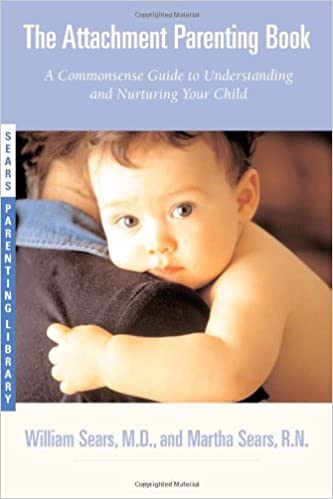In a world filled with parenting books and contrasting advice, “The Attachment Parenting Book: A Commonsense Guide to Understanding and Nurturing Your Child” offers a refreshing, intuitive approach to raising children.
Written by the husband-and-wife duo of William Sears, M.D., a pediatrician with nearly thirty years of experience, and Martha Sears, R.N., a registered nurse, childbirth educator, and breastfeeding consultant, this book champions the principles of attachment parenting.
This literary gem is highlighted in our best books for attachment parenting list.
Table of Contents
Introduction
This review of The Attachment Parenting Book will delve into the authors’ key concepts, strategies, and practical advice, helping you decide if this book is right for you and your family.
Attachment parenting is a high-touch, responsive style of parenting that fosters strong, healthy attachments and encourages parents to be consistently attuned to their baby’s needs. The book emphasizes learning and working with your baby’s unique cues rather than adhering to rigid rules.

The Sears’ approach seeks to demonstrate how attachment parenting benefits both parents and children, leading to improved development, easier discipline, and greater independence.
Pros and Cons
Pros:
- Intuitive approach: The Attachment Parenting Book encourages parents to trust their instincts and respond to their baby’s needs, creating a more natural and nurturing environment to help your child grow and thrive.
- Non-judgmental tone: The authors’ compassionate and empathetic writing style makes it easy for parents to feel supported in their parenting journey, even if they have made mistakes in the past.
- Comprehensive information: The book covers various aspects of attachment parenting, including its benefits, practical strategies, and scientific research supporting the approach.
Cons:
- May not work for every child: While attachment parenting offers numerous benefits, some children may not respond positively to all of its practices, such as baby carrying.
- Some impractical suggestions: The authors occasionally present ideas that may not be feasible for all families, particularly those with limited support networks.
The Attachment Parenting Book Overview and Key Concepts
Attachment parenting is a philosophy rooted in the belief that a strong early attachment between parent and child has numerous benefits.
The Attachment Parenting Book explains how this approach improves a child’s development, makes discipline easier, and fosters independence. Furthermore, the book offers guidance on implementing attachment parenting principles for working parents and advises weaning children from attachment parenting practices as they grow older.
In addition to presenting practical advice, the authors discuss scientific research supporting attachment parenting. This evidence-based approach reinforces the book’s key messages and provides parents with a solid foundation for understanding the rationale behind the suggested practices.
Strategies and Practical Advice
The Attachment Parenting Book is filled with valuable strategies and practical advice for parents seeking to adopt this nurturing, responsive approach.
The authors emphasize the importance of learning to read and respond to a baby’s cues, fostering a strong early attachment that sets the stage for healthy development. Parents can create a more harmonious relationship and avoid many common parenting struggles by paying close attention to their baby’s needs and signals.
One key aspect of attachment parenting is baby carrying, which the authors strongly advocate for its many benefits. However, they acknowledge that not all babies respond well to baby carrying, and it may not be a perfect solution for every family. Parents should be mindful of their baby’s preferences and adjust their approach as needed.

Handling fussiness and clinginess is another common challenge faced by parents. The Attachment Parenting Book provides useful tips on addressing these issues in a compassionate and understanding manner, easing both the child’s and the parent’s distress.
To prevent “mother burnout,” the authors suggest relying on extended family or friends for support whenever possible. While this might not be feasible for everyone, the underlying message is clear: self-care is crucial for parents, and seeking help when needed is a sign of strength, not weakness.
After all, “if baby is thriving, but Mom is completely burned out because she is not getting the help she needs, something has to change.”
Criticisms and Omissions
While The Attachment Parenting Book offers a wealth of information and guidance, it has shortcomings. Some readers may find that certain practices or recommendations do not resonate with their child’s personality or needs. For example, the authors’ strong endorsement of baby carrying may not suit all babies or situations.
Additionally, the book occasionally presents ideas that may not be practical for all families, such as relying on extended family or friends for support. This could lead to frustration or inadequacy for parents lacking such resources.
Despite these minor issues, the overall messages of the book remain valuable. Every child is unique, and parents should be prepared to adjust their approach to best suit their individual child’s needs. This is combined with the philosophy that “there is no such person as a perfect parent, and certainly this book was not written by perfect parents. Do the best you can with the resources you have. That’s all your child will ever expect.”
Who Should Read The Attachment Parenting Book
“The Attachment Parenting Book: A Commonsense Guide to Understanding and Nurturing Your Child” is an excellent resource for expecting and new parents and those struggling with traditional parenting methods or seeking a more intuitive, responsive approach.
Educators and caregivers who work with young children may also benefit from the insights and advice provided by the authors.
By promoting a strong early attachment, attachment parenting can pave the way for a more harmonious, joyful, and fulfilling parent-child relationship, leading to happier, healthier children and parents alike.
Conclusion
In conclusion, this review of The Attachment Parenting Book highlights the numerous benefits and practical strategies offered by William and Martha Sears for parents seeking a more intuitive, responsive approach to raising their children.
While some recommendations may not be feasible for all families, the book’s overall message remains powerful: trust your instincts, be attentive to your child’s needs, and adapt your parenting style to support your unique child best.
With its compassionate, non-judgmental tone, and evidence-based guidance, The Attachment Parenting Book is an invaluable resource for anyone seeking to foster a stronger, healthier bond with their child.
Related Book Reviews:
Review of The 5 Love Languages of Children by Gary Chapman and Ross Campbell

